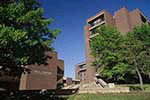Seminars & Colloquia Calendar
Emergence of Elasticity in Amorphous Solids
Bulbul Chakraborty, Brandeis University
Location:
Date & time: Wednesday, 27 October 2021 at 10:45AM - 11:45AM
The theory of elasticity of crystalline solids is one of the best-known field theories in physics. It emerges from the spontaneous breaking of translation symmetry and provides a complete description of the stress response based on the principle of momentum conservation, which relates the divergence of the stress tensor to external forces, and a constitutive relation between stress and the strain field, which is defined in terms of the displacements from the unique reference structure defined by the broken-symmetry phase. Applying this classical paradigm to non-thermal (non-Brownian) disordered solids is fraught with difficulties. To begin with, there is no obvious broken symmetry and hence there is no unique reference structure about which displacements can be defined. Alternatively stated, each mechanically balanced jammed configuration is equally eligible as a reference configuration allowing for a redundancy in definition of displacements that the course-grained observables are expected to be insensitive to. In addition, there is no free-energy functional since these solids are not in thermal equilibrium, and thus a rigorous basis for a stress-strain constitutive relation is lacking.
In this talk, I will discuss some of our recent work on the development of a theory of elasticity for such solids. Central to this framework is a gauge theoretic structure that arises from-- (1) the lack of a well-defined zero-stress reference configuration, and, (2) the local mechanical equilibrium of each grain in a non-thermal solid with the latter serving as a Gauss's law for a tensorial electric field. In this mapping, the forces act as charges of the so-called vector charge theory of a tensor electromagnetism first developed in the context of spin liquids, and force balance and torque balance are inherently incorporated in the structure of the theory. Computing the stress distribution in such amorphous solids then maps to solving the problem of electrostatics of this vector-charge theory in the presence of a dielectric. This stress-only framework is completely devoid of any reliance on a reference structure or displacement fields, which should not have any measurable consequences in amorphous solids. I will compare the theoretical predictions to experimental and numerical measurements of stress-stress correlations in jammed frictional and frictionless solids.
R. Shapiro Organizer's Page
Eilidh McKemmie -Charles Weibel Organizer's Page
Narek Hovsepyan and Ewerton Rocha Vieira Organizer's page
Ziming Shi, Sagun Chanillo, Xiaojun Huang, Chi Li, Jian Song Seminar website Old seminar website
Sepehr Assadi Seminar webpage
Jeffry Kahn, Bhargav Narayanan, Jinyoung Park Organizer's webpage
Robert Dougherty-Bliss and Doron Zeilberger --> homepage
Paul Feehan, Daniel Ketover, Natasa Sesum Organizer's webpage
Lev Borisov, Emanuel Diaconescu, Angela Gibney, Nicolas Tarasca, and Chris Woodward Organizer's webpage
Hong Chen Seminar webpage
Fanxin Wu and Nkhalo Malawo Organizer's website
James Holland; Organizer website
Organizers: Maxime Van de Moortel and Avy Soffer. Organizer's Page
Yanyan Li, Zheng-Chao Han, Jian Song, Natasa Sesum Organizer's Webpage
Organizer: Luochen Zhao
Yanyan Li, Zheng-Chao Han, Natasa Sesum, Jian Song Organizer's Page
Lisa Carbone, Yi-Zhi Huang, James Lepowsky, Siddhartha Sahi Organizer's webpage
Simon Thomas website
Kasper Larsen, Daniel Ocone and Kim Weston Organizer's page
Joel Lebowitz, Michael Kiessling
Yanyan Li, Dennis Kriventsov Organizer's Webpage
Alex V. Kontorovich, Vlada Sedláček seminar website
Stephen D. Miller
Organizers: Yanyan Li, Z.C. Han, Jian Song, Natasa Sesum
Kristen Hendricks, Xiaochun Rong, Hongbin Sun, Chenxi Wu Organizer's page
Fioralba Cakoni Seminar webpage
Organizer's webpage: Organizer's webpage
For information on the Statistical Mechanics Conference, visit HERE
- Show events from all categories
Special Note to All Travelers
Directions: map and driving directions. If you need information on public transportation, you may want to check the New Jersey Transit page.
Unfortunately, cancellations do occur from time to time. Feel free to call our department: 848-445-6969 before embarking on your journey. Thank you.



